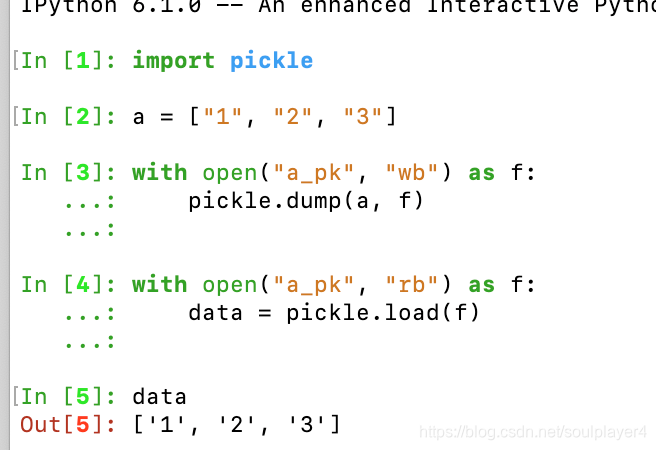程序生成数据
man = []
other = []
try:
data = open('sketch.txt')
for each_line in data:
try:
(role,line_spoken)=each_line.split(':')
line_spoken = line_spoken.strip()
if role == 'Man':
man.append(line_spoken)
elif role == 'Other Man':
other.append(line_spoken)
except ValueError:
pass
data.close()
except IOError:
print('The data file is missing!')
print(man)
print(other)
生成的数据进行保存(前半部分相同)
方法一:
try:
man_file = open('man_data.txt','w') #man_file为数据文件,man_data.txt为数据文件名,w为要使用的访问模式
other_file = open('other_data.txt','w')
print(man,file = man_file)#print()里第一个参数文要写入的内容,man_file为要写入的数据文件名称
print(other,file = other_file)
man_file.close()#完成工作时一点要记得关闭文件,以确保所有数据都写至磁盘,这称为刷新输出
other_file.close()
except IOError:
print('File Error')
finally:
if 'man_file' in locals():
man_file.close()
if 'other_file' in locals():
other_file.close()
方法二:
try:
with open('man_file.txt','w') as man_file:
print(man,file = man_file)
with open('other_file.txt','w') as other_file:
print(other,file = other_file)
except IOError as err:
print('File Error' + str(err))
pickle – "腌制"数据
pickle:python剔红了一个标准库,它可以保存和加载几乎任何Python数据对象,包括列表。
一旦把数据“腌制”到一个文件,它将会持久存储,可以在以后某个时期读入到另外一个程序。也可以将“腌制”数据存储在磁盘上,放在数据库中。
用dump保存,用load恢复
tips:必须以而禁止访问模式打开dump()保存的数据和load()恢复的数据
import pickle #导入pickle模块
with open('mydata.pickle','wb') as mysavedata:# “b”告诉Python要以二进制模式打开数据文件
pickle.dump([1,2,'three'],mysavedara) # 保存数据使用“dump()”
with open('mydata.pickle','rb') as mysavedata:
a_list = pickle.load(mydavedata) #使用“load()”从文件恢复数据,将恢复好的数据赋值给一个标识符
print(a_list)
dump
import pickle
man = []
other = []
try:
data = open('sketch.txt')
for each_line in data:
try:
(role,line_spoken)=each_line.split(':')
line_spoken = line_spoken.strip()
if role == 'Man':
man.append(line_spoken)
elif role == 'Other Man':
other.append(line_spoken)
except ValueError:
pass
data.close()
except IOError:
print('The data file is missing!')
try:
with open('man_file.txt','wb') as man_file:
pickle.dump(man,man_file)
with open('other_file.txt','wb') as other_file:
pickle.dump(other,file = other_file)
except IOError as err:
print('File Error' + str(err))
load
import liebiaoxianshi as lie
import pickle
new_man = []
new_other = []
try:
try:
with open('man_file.txt','rb') as man_data:
new_man = pickle.load(man_data)
with open('other_file.txt','rb') as other_data:
new_other = pickle.load(other_data)
except IOError as err:
print('File error:'+str(err))
except pickle.PickleError as perr:
print('Picking error:'+str(perr))
lie.print_lol(new_man)
错误描述
因为看文件夹中已经有man_file.txt文件,所以直接执行了dump 的程序,之后报错,数据怎么序列化进去很重要


第四章
教练给了4个人的秒数记录,让你进行排序
james:
2-34,3:21,2.34,2.45,3.01,2:01,2:01,3:10,2-22
julie:
2.59,2.11,2:11,2:23,3-10,2-23,3:10,3.21,3-21
mikey:
2:22,3.01,3:01,3.02,3:02,3.02,3:22,2.49,2:38
sarah:
2:58,2.58,2:39,2-25,2-55,2:54,2.18,2:55,2:55
但是你发现,这里面的数,进行排序的时候根本不是你想要的结果,你发排序之后,短横线>点号>冒号
所以你要将数字都进行规范化之后再进行排序操作
于是写了一个如下的函数,来进行符号的转换:
def sanitize(time_string)
if '-' in time_string:
splitter = '-'
elif ':' in time_string:
splitter = ':'
else:
return (time_string)
(mins,secs) = time_string.split(splitter)
return(mins+'.'+secs)
要点
- 集合中的数据是无需的,而且不允许重复
- 工厂函数:set(),创建一个空集合
- with语句利用了一种名为上下文管理协议的python技术
- wb 二进制模式写入,默认编码utf-8,
rb 二进制模式读取 二进制模式读取 - strip():从字符串中去除不想要的空白符
- print():BIF的file参数控制将数据发送/保存到哪里










 本文探讨了Python中数据的保存方法,包括使用文件保存数据的两种方式:文本模式和二进制模式,并介绍了pickle模块如何实现数据的序列化与反序列化。此外,文章还讨论了集合数据类型的特点及数据规范化的重要性。
本文探讨了Python中数据的保存方法,包括使用文件保存数据的两种方式:文本模式和二进制模式,并介绍了pickle模块如何实现数据的序列化与反序列化。此外,文章还讨论了集合数据类型的特点及数据规范化的重要性。
















 938
938

 被折叠的 条评论
为什么被折叠?
被折叠的 条评论
为什么被折叠?








